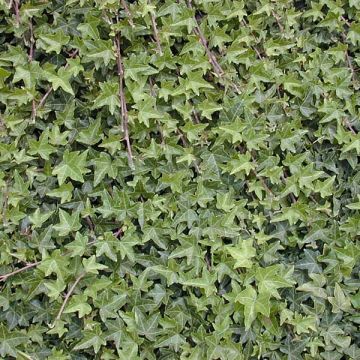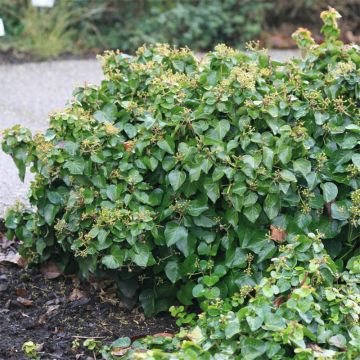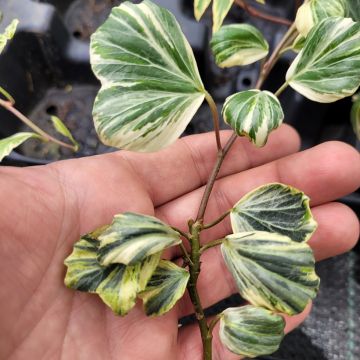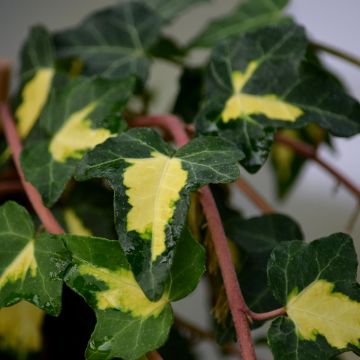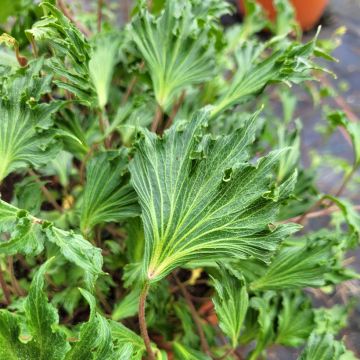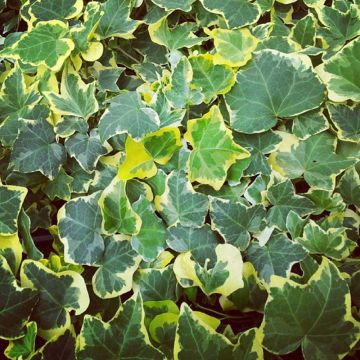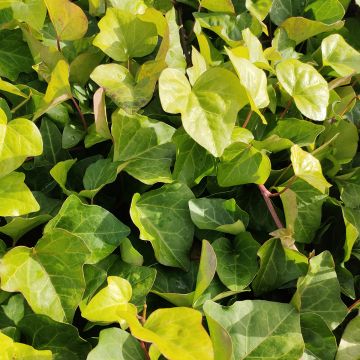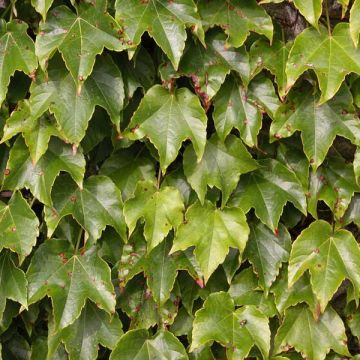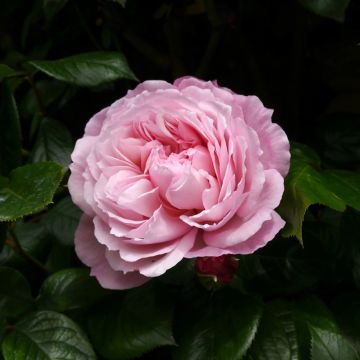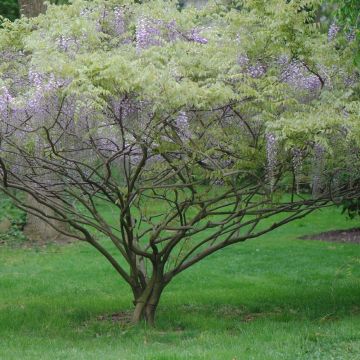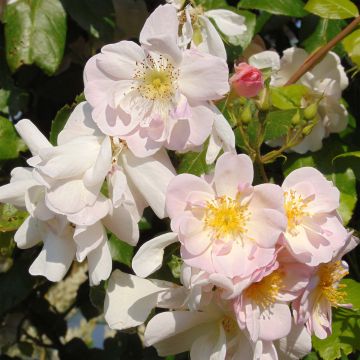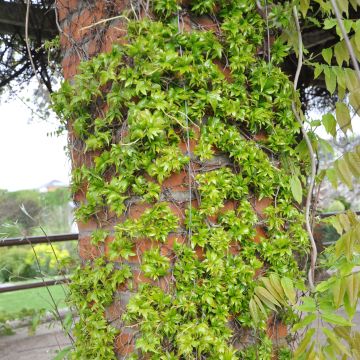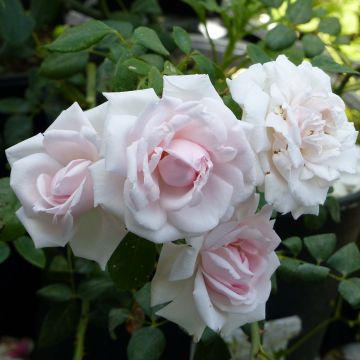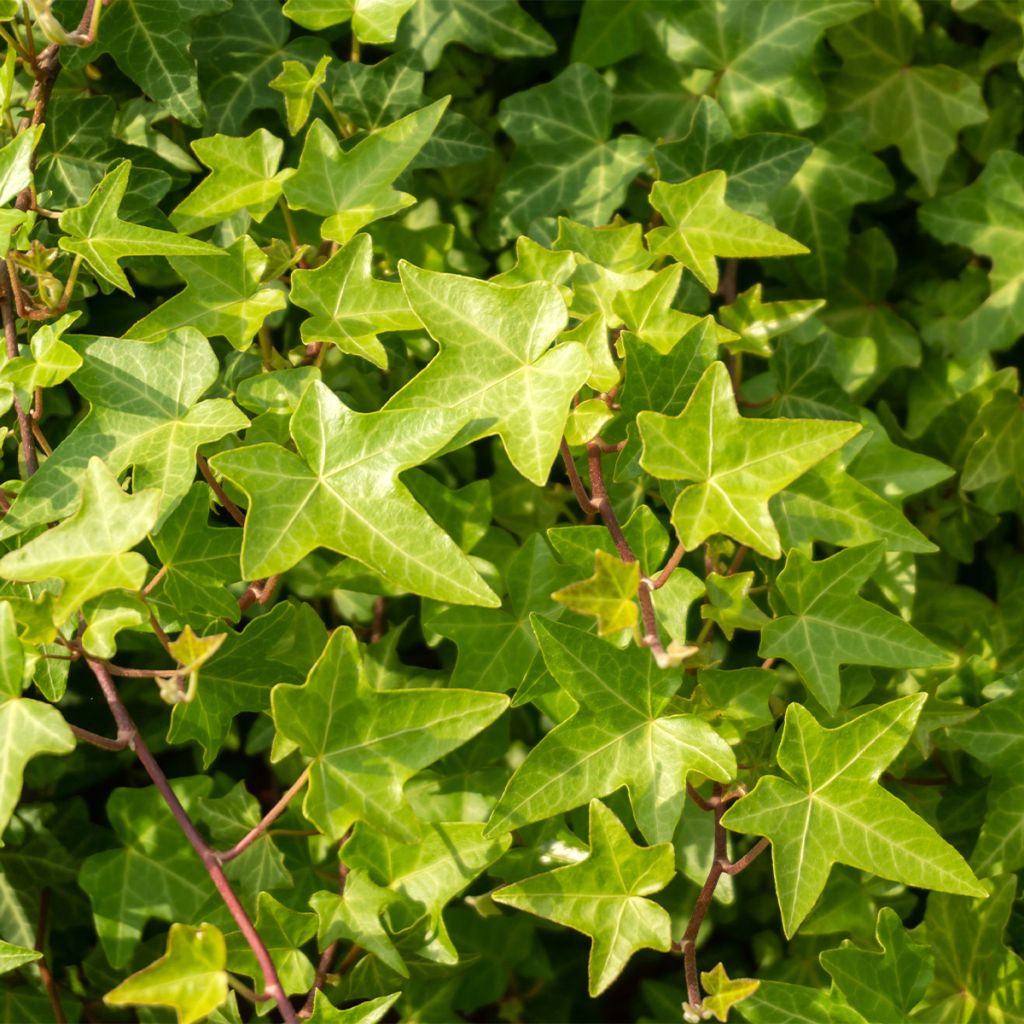

Hedera helix Shamrock - Common Ivy
Hedera helix Shamrock - Common Ivy
Hedera helix Shamrock
English Ivy, Common Ivy, European Ivy
This item cannot be shipped to the selected country
Delivery charge from €5.90
Delivery charge from €5.90
More information
Schedule delivery date,
and select date in basket
This plant carries a 6 months recovery warranty
More information
We guarantee the quality of our plants for a full growing cycle, and will replace at our expense any plant that fails to recover under normal climatic and planting conditions.
From €5.90 for pickup delivery and €6.90 for home delivery
Express home delivery from €8.90.
From €5.90 for pickup delivery and €6.90 for home delivery
Express home delivery from €8.90.
Does this plant fit my garden?
Set up your Plantfit profile →
Description
Hedera helix Shamrock is a very decorative variety of common ivy that remains attractive all year round. This variety is hardy and indifferent to soil conditions, like most of its relatives. It has small evergreen trilobed leaves of a beautiful shiny green colour. This dwarf variety does not exceed 1.5m (5ft) in height and is particularly suitable for terraces when planted in pots. As the ultimate climbing plant, this ivy can cling to any support to create a beautiful green decoration without the risk of it becoming invasive. It is an easy-to-grow plant that is valuable for decorating shaded areas of the garden.
Ivies belong to the Araliaceae family, which includes relatives such as ginseng and fatsias. This family has about fifty genera and hundreds of species, and it is quite varied, hosting not only trees and lianas but also shrubs and even some herbaceous plants. The Hedera genus includes about a dozen species, with the most common one in Europe being the common ivy or Hedera helix. This giant of European forests can reach lengths of several metres and climb to the tops of the surrounding trees.
Far from the botanical species, 'Shamrock' is a dwarf variety with much more modest growth. It generally does not exceed 1.5m (5ft) in height and 1m (3ft) in spread. Used as ground cover, this ivy can spread a little more, but never to the point of becoming invasive. Shamrock means clover in English, thus evoking its trilobed leaves. Although the leaflets are more elongated than round like clover, their miniature size (about 3cm (1in) long and wide) and their bright green colour are not so different. This shiny, evergreen foliage is decorative all year round and is the main attraction of this climbing plant. In autumn, the nectar from its inconspicuous green flowers, in the form of globular inflorescences, is an excellent source of food for bees at a time when few plants are in bloom.
The stems attach themselves to supports with powerful climbing roots. This ivy can therefore climb a wall or an arch, or even run along the ground. Very easy to grow, this climber thrives in most soil types, except excessively dry ones, and can tolerate limestone. It appreciates a certain level of soil moisture, but once well established, it is rather tolerant of dry conditions. It prefers partial shade or shade, or even full sun in cool climates, but it dislikes excessive sunlight combined with dry air. Hardy, it can withstand temperatures down to about -20°C (-4°F) and can be cultivated practically anywhere without requiring any particular maintenance. An ideal plant for small gardens and beginners.
Hedera helix 'Shamrock' will fit perfectly into a modern garden with its stylish foliage. Its small size makes it particularly suitable for planting in pots, where it can cascade down or climb on a trellis to decorate a balcony or terrace. When planted in the ground, it can serve as a nice ground cover at the base of a tree without the risk of it becoming invasive. It is valuable for enhancing semi-shaded or shaded areas, where you can combine it with other plants that have similar moisture requirements. Its miniature foliage will contrast with the lush leaves of Hostas, either green or bluish, or variegated with yellow or white. To create a scene that is as surprising as it is original, let this ivy weave its way between the clumps of the astonishing Acanthus mollis Tasmanian Angel, a large-leaved acanthus splashed with white. And for enjoying beautiful varied blooms, go for the perennial Geranium (the "true" Geranium in the botanical sense, not the Pelargonium that decorates our window sills), such as the Geranium maculatum var. album, a beautiful variety with bright white flowers.
Report an error about the product description
Hedera helix Shamrock - Common Ivy in pictures
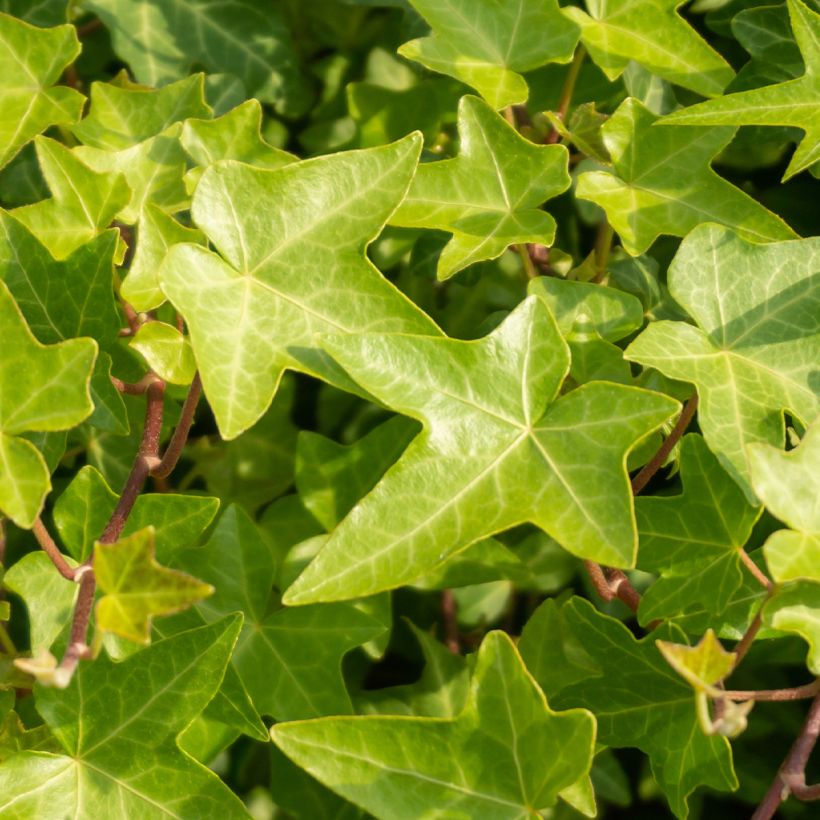

Plant habit
Flowering
Foliage
Botanical data
Hedera
helix
Shamrock
Araliaceae
English Ivy, Common Ivy, European Ivy
Cultivar or hybrid
Other Hedera - Ivy
Planting and care
Hedera helix 'Shamrock' is easy to grow in any ordinary soil and can be planted all year round. It prefers fertile, moist but well-drained soil, but is very adaptable (in terms of the presence of limestone or clay if the soil is well worked) and quite resistant to drought once established. Preferably, plant it against a wall in a semi-shaded position and sheltered from cold winds to help it establish, and monitor watering during the first 2 years after planting, especially in dry summers. To promote faster growth of young shoots, fix the first ones to the ground (layering). Don't hesitate to rejuvenate the plant by removing old branches.
For container cultivation, mix 7 parts ordinary soil, 3 parts compost, and 2 parts sand. Water regularly and apply fertiliser every month during the growing season. Keep the substrate moderately moist during winter.
Planting period
Intended location
Care
-
, onOrder confirmed
Reply from on Promesse de fleurs
Foolproof climbers
Haven't found what you were looking for?
Hardiness is the lowest winter temperature a plant can endure without suffering serious damage or even dying. However, hardiness is affected by location (a sheltered area, such as a patio), protection (winter cover) and soil type (hardiness is improved by well-drained soil).

Photo Sharing Terms & Conditions
In order to encourage gardeners to interact and share their experiences, Promesse de fleurs offers various media enabling content to be uploaded onto its Site - in particular via the ‘Photo sharing’ module.
The User agrees to refrain from:
- Posting any content that is illegal, prejudicial, insulting, racist, inciteful to hatred, revisionist, contrary to public decency, that infringes on privacy or on the privacy rights of third parties, in particular the publicity rights of persons and goods, intellectual property rights, or the right to privacy.
- Submitting content on behalf of a third party;
- Impersonate the identity of a third party and/or publish any personal information about a third party;
In general, the User undertakes to refrain from any unethical behaviour.
All Content (in particular text, comments, files, images, photos, videos, creative works, etc.), which may be subject to property or intellectual property rights, image or other private rights, shall remain the property of the User, subject to the limited rights granted by the terms of the licence granted by Promesse de fleurs as stated below. Users are at liberty to publish or not to publish such Content on the Site, notably via the ‘Photo Sharing’ facility, and accept that this Content shall be made public and freely accessible, notably on the Internet.
Users further acknowledge, undertake to have ,and guarantee that they hold all necessary rights and permissions to publish such material on the Site, in particular with regard to the legislation in force pertaining to any privacy, property, intellectual property, image, or contractual rights, or rights of any other nature. By publishing such Content on the Site, Users acknowledge accepting full liability as publishers of the Content within the meaning of the law, and grant Promesse de fleurs, free of charge, an inclusive, worldwide licence for the said Content for the entire duration of its publication, including all reproduction, representation, up/downloading, displaying, performing, transmission, and storage rights.
Users also grant permission for their name to be linked to the Content and accept that this link may not always be made available.
By engaging in posting material, Users consent to their Content becoming automatically accessible on the Internet, in particular on other sites and/or blogs and/or web pages of the Promesse de fleurs site, including in particular social pages and the Promesse de fleurs catalogue.
Users may secure the removal of entrusted content free of charge by issuing a simple request via our contact form.
The flowering period indicated on our website applies to countries and regions located in USDA zone 8 (France, the United Kingdom, Ireland, the Netherlands, etc.)
It will vary according to where you live:
- In zones 9 to 10 (Italy, Spain, Greece, etc.), flowering will occur about 2 to 4 weeks earlier.
- In zones 6 to 7 (Germany, Poland, Slovenia, and lower mountainous regions), flowering will be delayed by 2 to 3 weeks.
- In zone 5 (Central Europe, Scandinavia), blooming will be delayed by 3 to 5 weeks.
In temperate climates, pruning of spring-flowering shrubs (forsythia, spireas, etc.) should be done just after flowering.
Pruning of summer-flowering shrubs (Indian Lilac, Perovskia, etc.) can be done in winter or spring.
In cold regions as well as with frost-sensitive plants, avoid pruning too early when severe frosts may still occur.
The planting period indicated on our website applies to countries and regions located in USDA zone 8 (France, United Kingdom, Ireland, Netherlands).
It will vary according to where you live:
- In Mediterranean zones (Marseille, Madrid, Milan, etc.), autumn and winter are the best planting periods.
- In continental zones (Strasbourg, Munich, Vienna, etc.), delay planting by 2 to 3 weeks in spring and bring it forward by 2 to 4 weeks in autumn.
- In mountainous regions (the Alps, Pyrenees, Carpathians, etc.), it is best to plant in late spring (May-June) or late summer (August-September).
The harvesting period indicated on our website applies to countries and regions in USDA zone 8 (France, England, Ireland, the Netherlands).
In colder areas (Scandinavia, Poland, Austria...) fruit and vegetable harvests are likely to be delayed by 3-4 weeks.
In warmer areas (Italy, Spain, Greece, etc.), harvesting will probably take place earlier, depending on weather conditions.
The sowing periods indicated on our website apply to countries and regions within USDA Zone 8 (France, UK, Ireland, Netherlands).
In colder areas (Scandinavia, Poland, Austria...), delay any outdoor sowing by 3-4 weeks, or sow under glass.
In warmer climes (Italy, Spain, Greece, etc.), bring outdoor sowing forward by a few weeks.

































